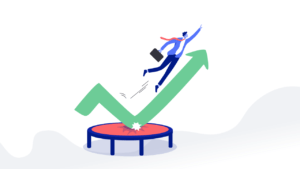Bounce Back Watch: The COVID Business Recovery Series
In this blog series we take a look at how different industries can bounce back better by developing a COVID business recovery strategy and responding to changes brought on by the pandemic that might impact consumer behavior. We start with an overview of some of the COVID pandemic impacts and what they may mean for marketers.
COVID-19 has been a rare reminder that, with everything that separates us around the globe, there are still some shared experiences that apply to us all. And while there are still regions where the pandemic rages on, many countries appear to be on the road back to normalcy, as governments, businesses and individuals start to recover from the tragedy and the damage.
Bouncing back from such a once-in-a-century catastrophe; however, will be a unique experience, fraught with threats and also rife with opportunities, on all levels. Before we dive in on certain industries, here are some of the changes the pandemic has brought about that need to be considered by companies, as they plan their COVID business recovery strategy:Economic Impact:
By mid-2020, the world economy was expected to contract by about $8.5 trillion in two years, resulting in an estimated 34 million people who will fall into poverty by the end of the year. An estimated 114 million jobs were lost due to the pandemic. Perhaps more importantly, over 60% of those people dropped out of the workforce, which may potentially impact the growth needed for recovery. Many economists anticipate that the cost of money will remain low for the foreseeable future, as governments prioritize growth over fiscal conservatism, while cash will be injected into the economy through various stimulus projects, thrust into the hands of those in need, until a more systemic approach can be implemented.
What can Marketers expect?
The public, on average, will have less money to spend and may therefore be more sensitive to price. A good COVID business recovery strategy might be to focus on existing customer relationships (no acquisition needed) and to generate goodwill by offering support, initiating projects to help hard hit communities and populations and demonstrating that you are not only interested in their wallet.
On the other hand, researchers expect “revenge spending” on the part of those whose income remained steady but had nowhere to spend it on.
Social Impact: 
The financial crisis has been felt around the globe, however, it has not been felt equally. The data in many countries shows that women, self-employed and low-medium skilled workers have been affected disproportionately. One reason is the dichotomous nature of the impact on entire industries: tech companies and digital economy companies have thrived, while hospitality, travel and service industries have been devastated.
Another reason is the widespread disruption of education systems; children of all ages were left at home and child-care services were almost non-existent. In the vast majority of cases, the women were the ones who had to give up work to tend the children. So in practice the pandemic made the income disparity much worse; people living paycheck-to-paycheck were thrown into financial uncertainty, while those higher up on the economic ladder could afford to take advantage of the various economic opportunities that came along.
In a more general sense, the call for social distancing has affected many people, so much so that the anticipation is that many will remain wary of human contact, even when such warnings will go away. The forced distancing also had darker impacts, leading to more stress, depression and loneliness. People naturally turned to “social proxies” such as social networks, however new research, confirming old research, shows that these proxies typically make things worse.
What can Marketers expect?
Audience segmentation will need to take into account these overall socio-economic changes, as marketers seek out their more promising targets. Companies that rely on those segments that have been impacted the most should be wary of losing their customers altogether with unwise, ‘tone-deaf’ engagement. The social media echo-chamber will still ring loudly, if less credibly. On the other hand, there is a hunger for in-person engagement, so events, parties and other get-togethers may see a lot of success, especially in the short term.
More importantly, in many cases the pandemic has disrupted customer relationships as businesses have focused on crisis-management. Beware: According to new research, “Loyalty has taken a bit of a hit as 56% of consumers admit to making purchases from new brands they’ve come across via social media”. Re-engaging with your customers positively should be a priority of your COVID business recovery strategy. Don’t forget to remind them how much you care, and why they liked you to begin with.
Technologi cal Impact:
cal Impact:
Lockdowns, social distancing and a general atmosphere of fear has left many people behind closed doors. This has been a boon for the digital economy (e-commerce grew 27.6% worldwide in 2020). Even people who had resisted, or been slow to adopt a ‘personal digital transformation’ were forced into it out of necessity, boredom or sheer loneliness. In parallel with the rise in use, however, came a rise in distrust of digital platforms stemming from well documented violations of privacy and the general uplift that conspiracy theories get during times of crisis. This coincided with tectonic shifts that were already in play to restrict 3rd party cookies and tracking, putting privacy much more at the center of the experience.
In addition, the circumstances turbo-charged the adoption of contactless technologies and in-home solutions, as a way to avoid personal encounters.
What can Marketers expect?
The inflection point of more digital savvy customers with the release of pent up ‘back to normal’ energy will generate a lot of opportunity for online-offline crossovers. Expect customers to flock to your stores, but with their phones ready in their hands. There will be less tolerance (and more concern) for queuing in stores and a greater expectation of convenience. A COVID business recovery strategy that facilitates smooth pickups and deliveries can keep your customers happy and your stores less crowded (a double win). Also, health concerns will still be top-of-mind, so make sure you communicate well, fast and often, regarding health regulations and alerts.
On the other hand, consumers are no longer ‘captive’ digital users and may generally prefer physical shopping or distrust/dislike the digital experience, so basking in your digital growth numbers from last year and expecting them to hold may be a fool’s errand.
We have laid out some of the main impacts of COVID-19 for businesses. In our next post, we’ll dive into one of the most hard hit industries of the pandemic.




